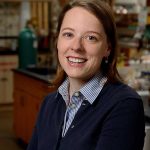Research Seminar
The visualization of molecular-level processes within living organisms should be considered a cornerstone of next-generation medicine. To that end, ultrasound can noninvasively image deep tissue with high spatiotemporal resolution but is lacking in molecular-level biosensors analogously available to other imaging modalities1. Gas vesicle (GV) protein nanostructures have recently been proposed as ultrasound contrast agents that are easily detectable in the context of living organisms. To date, GV characteristics have been engineered at the constituent protein level to achieve cell targeting, surface charge, fluorescence, clonability, and differential acoustics and collapse pressures2–4. More recently, GVs have been adapted as ultrasound biosensors that “light up” in the presence of protease activity5. While these advancements demonstrate the potential utility of GVs in a clinical setting, the toolset of ultrasound imaging can be further enhanced through the detection of small molecules. Herein is proposed three independent protein engineering aims focused on the central objective of generating acoustic small-molecule biosensors. In Aim 1, conditionally stable ligand-binding protein domains will be fused as chimeras to GV constituent protein gas vesicle protein C (GvpC). Aim 2 will install ligand-induced conformational switch domains within the sequence of GvpC through randomized transposon insertion. Aim 3 will discover mechanisms of ligand-responsive behavior through a library-based directed evolution strategy involving cellular buoyancy.
(1) Maresca, D.; Lakshmanan, A.; Abedi, M.; Bar-Zion, A.; Farhadi, A.; Lu, G. J.; Szablowski, J. O.; Wu, D.; Yoo, S.; Shapiro, M. G. Biomolecular Ultrasound and Sonogenetics. Annu. Rev. Chem. Biomol. Eng. 2018, 9 (1), 229–252. https://doi.org/10.1146/annurev-chembioeng-060817-084034.
(2) Lakshmanan, A.; Farhadi, A.; Nety, S. P.; Lee-Gosselin, A.; Bourdeau, R. W.; Maresca, D.; Shapiro, M. G. Molecular Engineering of Acoustic Protein Nanostructures. ACS Nano 2016, 10 (8), 7314–7322. https://doi.org/10.1021/acsnano.6b03364.
(3) Bourdeau, R. W.; Lee-Gosselin, A.; Lakshmanan, A.; Farhadi, A.; Kumar, S. R.; Nety, S. P.; Shapiro, M. G. Acoustic Reporter Genes for Noninvasive Imaging of Microorganisms in Mammalian Hosts. Nature 2018, 553 (7686), 86–90. https://doi.org/10.1038/nature25021.
(4) Lakshmanan, A.; Lu, G. J.; Farhadi, A.; Nety, S. P.; Kunth, M.; Lee-Gosselin, A.; Maresca, D.; Bourdeau, R. W.; Yin, M.; Yan, J.; Witte, C.; Malounda, D.; Foster, F. S.; Schröder, L.; Shapiro, M. G. Preparation of Biogenic Gas Vesicle Nanostructures for Use as Contrast Agents for Ultrasound and MRI. Nat Protoc 2017, 12 (10), 2050–2080. https://doi.org/10.1038/nprot.2017.081.
(5) Lakshmanan, A.; Jin, Z.; Nety, S. P.; Sawyer, D. P.; Lee-Gosselin, A.; Malounda, D.; Swift, M. B.; Maresca, D.; Shapiro, M. G. Acoustic Biosensors for Ultrasound Imaging of Enzyme Activity. Nat Chem Biol 2020, 16 (9), 988–996. https://doi.org/10.1038/s41589-020-0591-0.
Passcode: 1872

